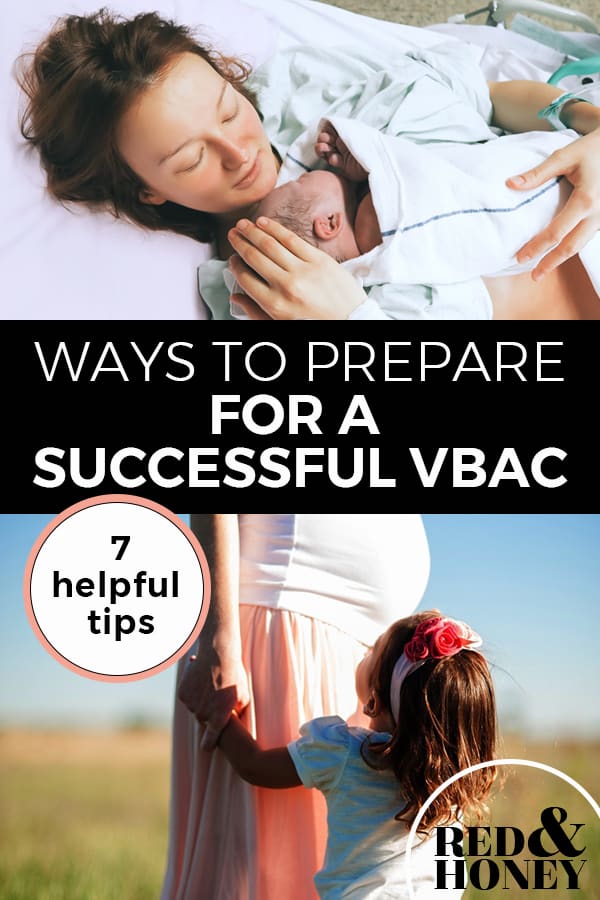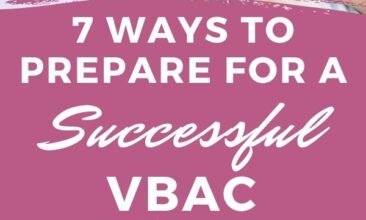
Post by contributor, Erin Long
In preparing for the birth of my first child, I basically skipped over everything to do with C-sections. I was young, healthy and my baby looked absolutely fantastic. I trusted my doctor and was delivering in Hungary, a country with a low C-section rate.
Why would I, of all people, have a C-section? I was ready to bring my baby into the world by my own strength and I had no reason to expect anything else.
But when labor wasn’t going as planned and my daughter’s heart rate started dropping, my doctor called for a C-section. I was completely taken off-guard and not prepared.
I knew I really wanted to deliver my daughter vaginally before she was born but not getting to do so revealed to me just how strong this desire was for the next time. There was nothing I wanted more than to bring my next baby into the world naturally through a successful VBAC.
A year later I found out I was pregnant again. I immediately began researching VBACs and spent countless hours pouring over books about natural birth and VBAC success.
I was determined to do everything in my power to have the birth I hoped for.
I was beyond blessed to deliver my son naturally with a midwife and while there were aspects of his birth that didn’t go how I would have liked, it was an amazingly powerful experience and I came away from it empowered and my daughter’s birth felt redeemed.
While there is the rare case where attempting a VBAC is not advised, almost every expecting mother should consider attempting a VBAC and almost all of them will be successful.
This success should not be left to chance.
A mother needs to make sure she has put the proper pieces in place that will support her during pregnancy and, most importantly, during labor and delivery.
While there is no way to guarantee a successful VBAC (there are no guarantees in birth!) here are 7 ways to increase your chances of a successful VBAC.

1. Choose a supportive provider
This is the crux of VBAC success: your provider has to not only support VBACs but truly believe in them.
Put yourself in the care of a person who not only understands that a vaginal delivery is best for you and your baby but also wants you to deliver vaginally. A provider might say they support VBACs but when push comes to shove and the slightest bit of a red flag flares up, they might get jumpy.
Choose someone with a history of successful VBACs and who is prepared to do everything in their power to make your VBAC a success.
These 48 Questions To Ask Before Choosing a Birth Care Provider are a great place to start and be sure to ask specifically about their VBAC philosophy and be willing to change providers if you don’t have confidence in them.
2. Consider a doula
If you’re delivering with a midwife, a doula might not be necessary. However, if you are under the care of an OB in a hospital, a doula is a vital component for success. A doula is trained to help you labor naturally, make informed decisions, and advocate for you if necessary. Women who birth with a doula are 28% less likely to have a C-section and have more satisfying birth experiences. The knowledge and support a doula offers could be the difference between a successful VBAC and a repeat C-section.
3. Research, research, research
Normally I don’t advocate extensive pregnancy research (there’s way too much fear-mongering on most major pregnancy websites) but this is one exception. If you understand the root cause behind your C-section, you can do your best to eliminate it as a factor in your next birth.
Also, know the facts about VBACs: 60 – 80% of women who attempt VBACs are successful, the American Congress of Obstetrics and Gynecology actually supports attempting a VBAC.
You probably did plenty of research about natural birth with your previous pregnancy but it’s definitely worth brushing up on pain management techniques, be encouraged by other birth stories and be reminded of the beauty of birth.
The more you know about VBACs and natural birth, the better equipped you will be to be your own advocate and to go into labor knowing that not only will you most likely be able to do this, you can do this!!

4. Be healthy
This goes for any pregnancy: the more healthy you are the greater your chances are of having a natural, healthy labor and delivery. Eat nutrient-dense real foods, exercise and stay active. You want to do everything you can to prepare yourself and your baby for a healthy, vaginal delivery.
Related: 6 Ways to Promote Healthy Gut Bacteria in Pregnancy and Newborns
5. Make your desires known
Whether this is a written birth plan, a thorough conversation with your provider or a birth partner who expressly knows your desires or all of the above, be confident that you have communicated your wishes and that they are understood.
How you do this could depend on who your provider is (I would recommend a written birth plan with an OB, while talking with a midwife could be enough) and your personality, but be satisfied that the key support players in the birth are on the same page as you.
6. If you’re delivering in a hospital, wait as long as possible to go
The less time you spend in a hospital, the less time there is for unnecessary interventions. Labor at home as long as you feel comfortable and go to the hospital only when you feel it’s necessary.
7. Give yourself grace
Because you’re attempting a VBAC, you’ve most likely already had a disappointing birth experience. Hopefully this birth will be one of redemption and you can feel the joys of birthing your baby vaginally.
But if it isn’t a perfect experience, and very few births are, that’s okay. If you have another C-section, that’s okay. Whatever happens you have brought a baby into the world and that, dear mama, is amazing.
Have you attempted a VBAC? What advice would you add?
(All photos except top image are from Beth Ricci)

























Payton
*you know you’ve has a traumatic birth experience when..* you choke up because a blog post says, it’s okay and you did amazing! Lol!
Niki Sweeten
Although some things in this may be helpful, I find this article distasteful by saying to WAIT AS LONG AS POSSIBLE TO GO IN, this is ridiculous. I went in after my water broke 2 weeks early and with no contractions. Not only did I have complications but flatlined on the table- had I waited and not gone to the hospital both I and my child would be dead. YOU ARE NOT A DOCTOR, and have no right to tell people to wait to go in to seek medical care that could potentially be useful in situations like mine.
Sara
Your situation was NOT the norm and was very unique. If you have PROM (premature rupture of the membranes), then you are at risk for infection and it is not advised to wait to go in. I’m SURE the author knows this. Her advice is for mothers who are not high-risk and do not have complications. She never claimed to be a doctor either. Calm down.
Crystal
I agree with Sarah. You have approximately 4 hours after your water breaks to get to the hospital to reduce the risk of infection by use of antibiotics. There are always exceptions to rules and that is why the author says to research.
Ashley
In a hospital there are greater risks for infection with PROM due to vaginal exams. Which are entirely unnecessary, invasive, and sometimes painful. My water was broken for 16 hours before my son was born at home with a midwife. The author clearly stated do your own research and be your own advocate. She didn’t mention advocating for others blindly based on personal experience. Every birth is different.
To OP of comment.
Jasmine
I know This post has been here a while But Niki just made me laugh! Great post! Ill be attempting a vbac in July and Im reading Everything i can Find and Also speaking to my OB &midwife 🙂
R&H Assistant
Good luck, Jasmine! Congratulations on your sweet one to come. <3
Heather
I really appreciate this article, especially the last point in #7. Most women should absolutely attempt a VBAC.
My 1st baby did not come “as planned” and I ended up with a c-section. Ultrasounds had shown she was overly large 9 pounder (which turned out to be a huge lie, she was a 6 pounder), but worryingly, she never dropped even a smidge toward the birth canal. After an 18 hour “failed” (I hate that word in the birth industry) induction, I caved and requested a c-section. My OB happily obliged. She had the cord around her neck twice, but I also worried a previous tailbone break prevented her descent.
When 2nd baby was due, I was much more educated and had researched. Older, wiser, less naive. I regretted the c-section and believe I was pressured (albeit gently) into it. So I had a new OB and he was an older man, about to retire, but I’m happy to report he encouraged me to try the VBAC. He said since I never got to the pushing stage with #1, there was no reason to think I couldn’t “pass” a baby. But my due date came and went. My doctor tried to schedule me to be induced twice, but knowing the domino effect I refused. I went TWO WEEKS overdue before I finally went into labor. I had cried about it daily during those two weeks. I was miserable, my doctor was getting angry with me that I wouldn’t let him induce me. I wanted the VBAC so bad.
24 hours of painful contractions in, I finally went into the hospital. 24 hours of labor and they said I was dilated to 2, and they were being generous. The baby hadn’t dropped a smidge. Same pattern now as the first baby. I got an epidural finally, and 34 hours into labor I agreed to the c-section.
When #3 was born, obviously, I planned the c-section all along.
So I definitely appreciate those who encourage VBACS, and yes, USUALLY they do work out just fine! But if I could go back and do it differently, I wouldn’t have waited so long with #2. IN the end the result was the same. Don’t let your doctor call it a “failed” VBAC. But I also don’t like telling moms they should just be happy no matter what their experience was, as long as baby is healthy. No, our experiences matter too. You seemed to address this with your post, so thank you!
Christy Lopez
I too was devasted when my first had to be delivered via c-section for the same reasons and again I too was adamant I was going to have a successful vbac. However, I did not. It still haunts me two years later. I mourn for the experience of a natural vaginal birth that I’ll never have.
I believe whole-heartedly all women should be encouraged under the correct medical conditions to attempt a vbac. But to send the message that it overwhelmingly successful really brings a feeling of shame for those of us who were not.
Furthermore and most importantly there is some very dangerous advise in this article! I went to the hospital once regular contractions started. Had I waited or been sent home only being 1 cm, my baby and possibly myself would have died! Had I not been in a hospital with a full surgical team present my baby would not have made it. Even with an epidural line in place (my hospital’s policy, yet I did not have the actual numbing mess flowing through it in my attempt for a natural birth) it still wasn’t enough preparation to get my child out in time. In fact, they were not even able to sedate me quickly enough before having to begin cutting. Yes I was fully conscious at the start of the csection, and I was ok with that as I was literally begging them to get him out and save my precious little boy’s life! So, when doing your research and understanding the risks of a vbac you need to know that being in a hospital is essential with the utmost careful monitoring, and women need to be there early in their labor. I was only 4 cm dialated 30 min prior to needing that csection, four hours after arriving to the hospital. I know many women who have had a successful vbac and the statistics were and are in women’s favor, but the risks are real, they do happen, and extra precautions must be taken.
Margi
I had 3 C-sections, then a successful hospital VBA3C… I did all of these things, plus chiro and acupuncture and it happened! What a beautiful birth… I will never forget how beautiful it was to be “involved” in the birth process!
Mom of one
Wow that’s amazing – how did you prepare yourself for the vbac after 3 c sections? How long ago was your last c section?
Heather G
Wow! Did you do Chiro throughout as well as acupuncture? That’s such an uplifting thought having a successful VBA3C!
Morgan
I was really hoping to hear a story like yours. U believe this is amazing and would love for your to bring some insight as to tips taken to be successful with the vaginal birth of ur child. How hard was it to find a doctor to support your decision and so forth?
Marci
This was a great article – you are exactly right about the importance of preparing for a VBAC. In my first birth, I became a homebirth-cesarean mom (planned homebirth, but ended up with transfer and a csection). She was ROT prior to labor but turned OP during labor…and never got out of that position, no matter what position I tried, etc. I had a 56 hour labor: seven of those were in the hospital with pitocin. I stayed pain med free the whole time and had a midwife and a supportive husband. But when fetal tachycardia became extended, both the doctor on call and my midwife felt it was time for a c-section. My daughter was born with an Apgar of 2 and a code pink baby – she was recessitated for a long time at birth and then ended up in the NICU for a couple days. Not exactly what I’d had in mind when I did Bradley method classes for my husband for 12 weeks :). I did actually have a section of my birth wishes that discussed my preferences for a c-section birth if it became apparent we needed one, but by the time I had my c-section everything was so urgent that those wishes weren’t even on *my* mind.
Baby number two – homebirth and 44 hours of labor. Midwives, husband, and doula with me. 42 of those hours contractions were consistently strong and 8-10 minutes apart. She was ROT till 42 hours into labor, at which point she turned LOA, dilation shot up. One hour and eight minutes after my contractions dropped from 8+ minutes to every two minutes, she was born into the water birth pool after just over 20 minutes of pushing…beside my fireplace and christmas tree New Years day 2013 :). She was 6 oz heavier than my first baby had been – she weighed in at 7 pounds, 6 oz 🙂
During the pregnancy, you wouldn’t believe how many folks were negative and all about “why didn’t I just have an RCS?” I believe in a woman’s informed consent and it is fine if a woman chooses to have an RCS, but I find that there is often such discouragement if a woman says she’s going to have a vbac. It is time for people to realize that VBAC is a safe, healthy option for many mothers. I feel very blessed to have had a healing VBAC with my second baby girl and feel so thankful that I had that experience. This is why reseach is so important – so many women rely on their girlfriends, mom, or aunt to tell them what is safe. “My doctor told me X wasn’t safe but Y is safe” etc etc. The people is, when you listen to these people (yes, they love you, but folks who love you can unwittingly pass on inaccurate information) you can end up limiting your own birthing choices because of taking the second or fourth-hand account of what someone elses “doctor said”. And unfortunately, many doctors DO pass on inaccurate information about VBAC. I had a friend who was told by her doctor that she was selfishly risking her baby’s life by having a vbac. He told her she was physically too tiny to have a vaginal birth. Where does the medical literature show that a small woman cannot have a VBAC??? NOWHERE. But this is what he told her. She went on to have a VBAC anyways – her VBAC was 3 hours long from first contraction to birth! The baby she’d been c-sectioned with was 6 pounds; her VBAC baby was 8 pounds 13 oz!
Research research research if you want a VBAC, ladies :). There is nothing wrong with trying 🙂